Menus
- Homemade hotrod
- 649cc Triumph twin, Norton Manx clutch and fork, 48hp, 129kg dry
- Discovery
- In the saddle
- Test
- Conclusion
Homemade hotrod
649cc Triumph twin, Norton Manx clutch and fork, 48hp, 129kg dry
Superbike racing and its Supersport derivative are largely responsible for the disappearance of the art of special preparations. Nowadays, when you can walk into any multi-brand dealership and be spoiled for choice when it comes to purchasing a street-legal motorcycle that delivers a level of performance similar to the MotoGPs of a decade ago , there is not much to gain from riding with your own creation, in addition to the fact that you will not be able to compete in these competitions, which are mainly based on production models anyway.. Imagine if John Britten was still alive and had just created the engineering work of art that was his magnificent V-Twin sports car. He would have nowhere to run, except in the Open class of the Senior TT on the Isle of Man….
 Monard 650 review
Monard 650 review
Discovery
But 60 years ago the low availability of racing motorcycles to customers (the Nortons Manx were carefully rationed, the AJS 7Rs as well and both cost a fortune anyway) meant that in post-Britain -War, the road to a competitive career involved modifying a motorcycle that you used to ride for everyday life, or better yet, concocting your own race preparation in order to give free rein to his own technical convictions. Few have done it as successfully as Geoff Monty and Allen Dudley-Ward. Their Monty & Ward dealership in Twickenham was in the 1950s and 1960s the breeding ground for a series of preps bearing the GMS and Monard names which, over their long decade of track success, have been the cream of the crop. the cream of British preparations on the circuit.
The two partners had teamed up to start a motorcycle business in 1946. They thus built, prepared and hired motorcycles for themselves and their customers. And over the years it has grown into one of the UK’s biggest dealerships.
Among all their creations is the GMS (Geoff Monty Special) which, in the hands of its creator, beat most of the other 250s in the British races of the 1950s, "except John Surtees on his NSU Sportmax. I could beat anyone else, but him never! " I had slipped the mustached Geoff on one of my visits to Monty & Ward in Edenbridge, Kent. He remained at the helm of the company almost to the end before passing away in 2008 at the age of 92..
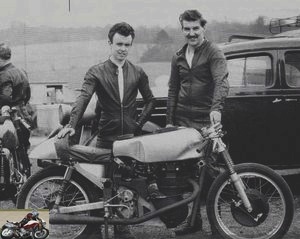 Tommy Robb and Geoff Monty with the GMS 250 in 1959
Tommy Robb and Geoff Monty with the GMS 250 in 1959
Built in the winter of 1955/56, the GMS 250 consisted of a short-stroke BSA engine, mounted in Monty’s own ultralight backbone frame and clad in an aluminum Dustbin fairing, also made by Monty & Ward. Two copies of this frame were built, one to house the Pike-BSA 250 engine, the other for a Class 350 motorcycle that used a Gold Star engine. But the latter will never know the success of the GMS 250 which was really competitive. It must be said that the engine was developed by the late Roland Pike, head of the manufacturer’s experimental department and also a good pilot..
In building the two BSA powered GMS machines, which were later made into the Triumph-powered Monard, Geoff Monty used 2 gauge 16 gauge steel tubing.¼ inches to design the base of a composite frame using the geometry of the Norton Manx, but much lighter. It will be the precursor of the chassis of the Egli brand which will see the light of day a decade later, with its engine suspended behind two tubes descending in Reynolds 531 (the one on the left integrating the lubricant for the primary chain), without lower rail, but with a long axis for the box-section swingarm. Aluminum side plates and a rear subframe on which the upper ends receive bolt-on Girling shocks complete a featherweight chassis encompassing the Triumph engine and Norton gearbox to create a design worthy of a factory creation rather than a Twickenham workshop. The fact that these two motorcycles have raced intensively for 20 years with a variety of displacement ranging from 250 to 750 cm3 while remaining competitive until their retirement, says a lot about the technique and the quality of know-how developed in the creation of these GMS / Monard preparations.
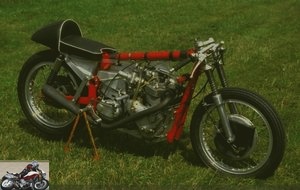 The frame is made from a central steel tube
The frame is made from a central steel tube
After his first victory in the 250 race at Aintree in 1056, the GMS met with many successes with Geoff Monty in the country and abroad during the following three years, including on outings to race in the Scandinavian Grand Prix of Sweden. and Finland. But while Geoff has always been careful to make the race profitable, even though he entered into primarily for fun, the demands of a growing business led him to retire from racing. and to call on other pilots under the Monty & Ward banner. Among them, Alan Shepherd, Mike O’Rourke (11th in the 1957 Lightweight TT for the first appearance of the GMS 250 on the Isle of Man), Ron Langston, future Formula 1 driver Bob Anderson and future winner of the ‘Ulster GP Tommy Robb who immediately took the measure of his GMS by winning the North West 200 in 1959 and then finishing 4th behind the factory team MV Agusta at the Lightweight TT before proving it was no accident by finishing at new 4th in Ulster GP. Eighth in the World Championship and numerous successes on the British circuits during Robb’s three seasons on the bike underscored the value of the GMS as the most successful 100% British sports car. This allowed Tommy to join the official Honda team in 1962 and gave Geoff Monty some satisfaction, over how he lost his next star driver….
Robb’s departure effectively marked the end of the road for the 250 GMS, as the single-cylinder engine was now overtaken by more powerful multi-cylinders. But in 1962, Honda asked Monty & Ward to prepare three 50cc road bikes for an endurance test at Goodwood aimed at demonstrating the then unproven reliability of the Japanese firm’s productions by running them for a week. continuously with a team of 19 pilots. One of them was a promising youngster named Bill Ivy. After seeing it in action for 7 days, Geoff Monty knew he had found the pilot who would reward the time and expense necessary to breathe new life into his pair of preps..
 Geoff Monty and the Monard
Geoff Monty and the Monard
To achieve this, the 250 GMS was then transformed into the 500 Monard, still with the same chassis, but now fitted with a long-stroke Triumph Tiger 100 twin and tuned by Allen Dudley-Ward. The 350 cc becomes a 650 Monard with a Triumph Bonneville engine tuned for the Unlimited categories. But Ward’s work was not finished because in 1964 he replaced the 500 Triumph with a special 71 x 62.5 mm short stroke version with oversized cylinders, a one-piece Laystal crankshaft, special cams, a reworked cylinder head, high compression pistons, nimonic alloy valves and a lower intake port. Paired with an Aagard 5-speed gearbox and a Norton dry clutch, the twin Monard 500 peaked at 9,000 rpm. His sister 650, less worked but just as competitive, allowed their young driver to make a name for himself in British racing, becoming a serious threat to the established order for stars of the time like Derek Minter, John Cooper, Dave Croxford, Dan Shorey, Dave Degens and Ray Pickrell. Ivy’s fifth place with the Monard 500 on the Mallory Park race, behind the victorious MV of Mike Hailwood, but ahead of Minter and many aces in Norton, under the gaze of 40,000 fans devoted the first season of "Little Bill "on Triumph twin preparations.
A regular top 6 competitor on both bikes, Ivy never won a national event on either, but was always here and there in the fight for victory. The Kent pilot’s exploits aboard home-made preps against the more exotic and expensive GP pilots gave outsider status to a racer whose tiny stature and the way he slipped behind the fairing left still believe he was eclipsed by the huge motorcycle. In fact, the Monards were much smaller and lighter than their Norton rivals, while still maintaining the same geometry and 1,435mm wheelbase with reduced Manx Roadholder forks. These accentuated their small size, 50 mm shorter at the steering head than a Manx. It must also be said that Geoff Monty fitted 18-inch tires, initially to improve braking stability, compared to the original 19-inch Nortons..
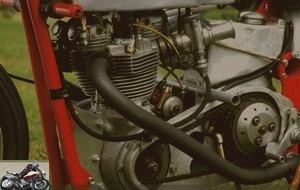 It is then a Triumph twin-cylinder of 649 cm3 which will be installed in the motorcycle.
It is then a Triumph twin-cylinder of 649 cm3 which will be installed in the motorcycle.
Geoff’s focus was on weight reduction, another reason he couldn’t wait to let Ivy pilot her. Should we also talk about the Manx drum used at the front and coupled at the rear with an SLS and an extra long arm to prevent wheel movements on heavy braking. The weight saving went so far as to apply the minimum amount of paint! The bike had just sections of the frame in red, with dural side plates and a copy of the white fiberglass Yamaha TD1 fairing (Monty & Ward was the first Yamaha dealer in the UK) left raw. The result of these details and many other points aimed at reducing weight resulted in a Monard 650 weighing only 130 kg dry and delivering 48 horsepower at the rear wheel, the same horsepower as a single cylinder DOHC 500 Manx. cm3 18 kg heavier and which was also larger with a larger frontal area. It wasn’t just "yet another damn prep" !
This also served as a test bed for a range of Monty & Ward parts for the Triumph twin cylinder range with items such as a larger capacity oil pump, fin crankcase, rocker arm oil supply. as well as aluminum pushrods, rockers and pinions, all marketed by the Twickenham firm after development on Monard sports cars. It was even envisaged at one time to produce a short series of Monard Replicas equipped with engines prepared according to the customers’ choices. But this did not come to pass, although plans were made to step up racing activities in 1965, still with Bill Ivy as the driver. It must be said that the latter had still marked the spirits by winning the British title 125 on a Honda CR93.
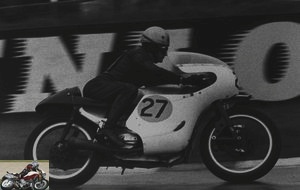 Bill Ivy on the Monard 500 at Brands Hatch in 1964
Bill Ivy on the Monard 500 at Brands Hatch in 1964
From the flag lowering at the season opener at Mallory Park in March 1965, Ivy was in Olympic form, never finishing beyond fourth in any race to start the season. By Easter, he had already participated in 20 races. So when he crashed with the Monard 650 in the Mallory Park hairpin bend on Easter Monday, Geoff Monty interpreted it as an early season burnout when the little rider told him he "didn’t want to ride a big bike anymore. ".
Geoff monty :
I told him he had hurt himself a bit after a rough weekend and suggested he go home, get a good night’s rest and think about it before making any rushed decisions. He called me the next night and told me he was going to ride for Tom Kirby and he wouldn’t run on my machines anymore, sorry and thank you anyway. I was upset, it was a terrible way to behave on their part.
Yet after this unfortunate episode, the Monards’ worth was confirmed by the men who replaced Ivy on motorcycles. First John Blanchard who immediately entered the points at Brands and Mallory, then Ray Pickrell, who marked enough in 1967 to be recruited by Dunstall the following season. For 1968, the motorcycles were handed over to M&W tuner Roy Francis, a close friend of Ivy who had kept in touch with the company after his buddy left and had previously ridden smaller capacity motorcycles for Monty. In his very first race on the 500 Monard, Francis defeated Peter Butler in his 650 Boyer-Triumph to claim the Lord of Lydden title on his national circuit, then clinched a second place photo-finish on the 650 in the Hutchinson 100 at Brands, before another victory at Crystal Palace, this time against Dave Nixon in the Boyer-Triumph.
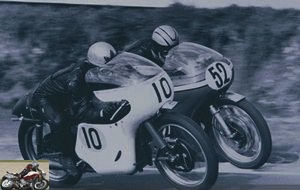 Bill Ivy on the Monard 650 facing Ray Pickrell on the Dunstall Norton
Bill Ivy on the Monard 650 facing Ray Pickrell on the Dunstall Norton
Roy Francis :
I had spent the winter of 68/69 rebuilding the Monards and thanks to Geoff and Allen’s attention to detail, I was getting good results every time. But then came that terrible day in 1969 when Bill was killed riding the Jawa 4 cylinder in East Germany. I was at Monty & Ward working on motorcycles when the news came on the radio. I just couldn’t believe it. I threw the keys away and put the things away. I got out, got in the car, and came home like it was all a bad dream. But it wasn’t and when Bill was killed there was no question of driving. I was coming to lose interest.
It was almost the end of the road for the Monards as well as although Martyn Ashwood and John Taylor both drove them in 1969/70, Geoff Monty’s interest was now focused on developing the Triumph 750 engine prep. eight valves mounted in a Rickman Metisse frame. The last man to drive the Monard, now in the 750 version but still with four valves, was Keith Martin, who finished fourth behind the Triumphs of Pickrell and Smart and John Player Norton of Peter Williams in the 200 mile F750 race at Thruxton in 1972. This was the last major outing for this machine whose racing career spanned two decades; always against all expectations…
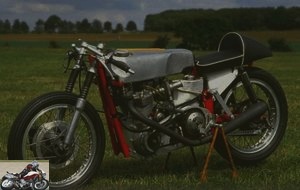 The Monard will run for almost two decades in competition !
The Monard will run for almost two decades in competition !
After removing the Monards for good, Geoff Monty took them apart and stored them in Ali Baba’s cave of mechanical masterpieces that was his Edenbridge store, alongside machines as exotic as the 125 Villa de Chas Mortimer, the ex-Pagani 500 Linto or his Alfa Romeo Montreal V8 coupe. Repeated attempts by various enthusiasts to acquire it all failed, until the civil engineer Mike braid finally did it in 1999 for the best of reasons:
Let’s go back in time to 1964 and a test day at Brands Hatch. Geoff Monty was there with Ivy on the two Monard and a Yamaha 250, it was the first time that we saw them. A friend and I had made a Triton out of an old Manx Rod Gould that we had built with a completely revised cylinder head Triumph Tiger 100 engine, so we knew enough about what Geoff had done with the Monard to really appreciate his work. They were works of art.
Over the next semester, I got particularly interested in Monard, every time Ivy was riding one of them. As far as I can remember he never won a race with it but he was still in the top 6 and given the humble origins of what really just a build that anyone could have built with half the talent of Geoff and Allen, I have always appreciated them. I actually asked Geoff to buy one of the chassis kits he was supposed to build because I had considered building a replica of Monard after removing all the parts from my Manx and recycling them. But that never happened and I then agreed with Geoff that after Blanchard finished fourth at Mallory in the fall of 1965 with the 500 that the bike was completely dismantled and never rode again until I buy it and rebuild it. The 650 which was a 350 remained complete and was converted to a 750 and then raced until the mid-1970s until a connecting rod broke during a day of testing. After that it was in storage until Geoff sold me the two bikes in 1999. I knew Roy Francis had expressed interest in having one, as a tribute to Bill Ivy as well as his own memories with the bike. So I made arrangements to give him the 750 right away. Geoff also provided me with a 650 race engine, which I’m assuming was the one Ivy raced with, before upgrading to the 750. So since it was ready to go and only needed checking, that’s the one I used to assemble the motorcycle. This is how the one that was originally the 250 GMS later became the 500 Monard and now the 650 Monard! "
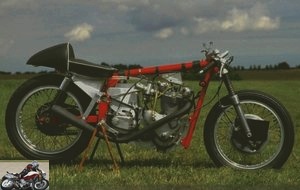 Wisely stored, the Monard was rebuilt by Mike Braid in 1999
Wisely stored, the Monard was rebuilt by Mike Braid in 1999
Suffice to say, imagining being able to get the chance to get on this historic motorcycle to test drive, increased the pressure and the excitement..
In the saddle
This Monard is both as original and authentic as any other prep that has evolved over the years to become what it was meant to be. I can attest to this by having been able to pilot the Monard in its 650 configuration one day on the road at Mallory Park. The riding position immediately betrays the age of the bike and its roots. It offers the same lying position as a Norton Manx except that you feel seated much lower. Although I still couldn’t quite hide my head behind the Yamaha fairing bubble. Obviously, here we are dealing with Too-Tall Al rather than Little Bill.
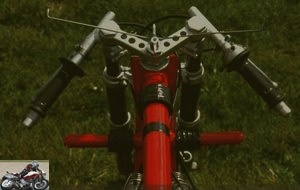 The driving position is very typical for the race
The driving position is very typical for the race
The reverse Smith tachometer takes a little getting used to. But after successfully starting the Monard with the help of a certain Phil Read and rediscovering the low rpm vibes typical of those Classic-era British racing twins, we found that the Monard’s Manx clutch was slipping. Phil’s idea of adding an extra clutch disc came in handy and then I was able to hit the track for the Monard’s first ride in several decades, before Mike Braid assembled it again and don’t give it a second wind.
 A little helping hand from Phil Read (left) to restart the Monard for the first time, here with Alan Cathcart, Fred Walmsey, Andrew Cathcart and Mike Braid
A little helping hand from Phil Read (left) to restart the Monard for the first time, here with Alan Cathcart, Fred Walmsey, Andrew Cathcart and Mike Braid
Test
The result approaches more of a rough size than a thoroughbred, a house hotrod of sorts that was dynamically powerful for its time. I never saw Bill Ivy ride the bike, but I can understand after riding him how in his 650 form he had the best chance of success. Even a short stroke pushrod twin of up to 9,000 rpm would have struggled against the racing Norton Manx, but you can feel that, especially with this featherweight, this version performed well for its time. Even though the symphony of the silencer is heard very low, there is not much power below 5000 revs. So you have to drive with the clutch to get out of Mallory’s hairpin bend quickly. Taking advantage of the long, wide track there is the best way to keep up the momentum and therefore the revs. With what looks like sluggish cams, the engine likes to be kept at a brisk pace. The power at mid-range is not that great, but on the contrary it seems quite powerful at the top.
 Bill Ivy Monard 650 review at Mallory Park
Bill Ivy Monard 650 review at Mallory Park
However, the gears of the Swedish Aagard 5-speed gearbox with its right-foot gear selector are very well suited to the power nature of the Monard, allowing for quick, clutchless gear changes as the engine nears. its peak power of 7,500 rpm. Ironically, this is where the engine really smooths out. Because if the vibrations are still present, they are no longer excessive. This is mainly noticed via the alloy bracelets rather than at the level of the footrests or the saddle. Even if after turning on the bike in the paddock and vibrating my dental fillings at low speeds, I was not really looking forward to getting into the laps on the track.
Unlike other British 360 ° parallel twins from the mid-1960s that I have flown, it has the same characteristics as a 180 ° twin like the Patons, with a vibration that fades as the engine rises. diet. Trumpeting down the Mallory straight with the unmistakable boom of a prepped twin triumph and those twin megaphones mufflers, however, revealed an undeniable pleasure, especially as the engine smooths over the last 500 laps before shifting to gear. greater than 7,500 rpm.
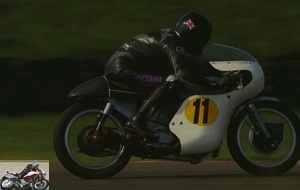 48 hp engine vibrates less or less as it approaches 7,500 rpm
48 hp engine vibrates less or less as it approaches 7,500 rpm
While the stretched riding position looks a lot like that of the Manx, the similarity ends there as the handling is quite different, better in some ways, worse in others. It was also this point that made it a fascinating showdown for the Ivy / Monard duo against the Nortons as Bill was able to shine in places neither of his rivals could, but they had the advantage at other times..
Where the Monard excels is in angle changes in tight turns. But it has a tendency to understeer under acceleration. Although the front brake stops this lightweight bike perfectly, it is just fine and the heavier double drum fitted to the 1961 Manx that I was able to ride at Daytona and Assen for Ian Telfer significantly reduced stopping distances with a biting more pronounced. However, this observation is made with a pilot weighing twice as much as Bill Ivy. So it’s likely that Monty was right to go for a thinner, lighter brake. I could still make sure that I slowed the Monard enough at the entrance to the Mallory hairpin by pressing firmly on the rear brake pedal and squeezing the front lever with all my might. However, there is no margin for error. If someone passes you or takes you inside, the risk is constant and even more in the heat of the race on a circuit of the 60s..
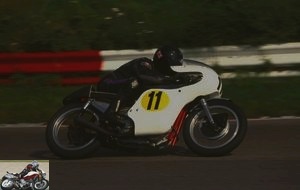 Manx’s drums are just enough to stop the Monard
Manx’s drums are just enough to stop the Monard
However, taking a curve when coming in hard on the brakes, or switching from angle to angle in the chicane is very easy thanks to the bike’s light weight, which means that it also handles bumps very well at the back. Gerard came out despite a tightened preload at the rear to suit my excess weight compared to Bill. What happened immediately after, however, is not so good. The Monard slips its ribbed Avon front tire sensibly on strong acceleration on the right angle as Gerard exits and we try to keep it here every pass. This is also the case in the Esses and in the Devil’s Elbow. Maybe it’s a consequence of the low weight or my extra pounds lowering the rear a bit, but the bike as a whole doesn’t feel as well balanced as a Norton Manx and certainly doesn’t handle as well. Interestingly, although I failed to get the Monard to wobble, which was apparently a common occurrence when Bill was in the driver’s seat and came out of a fast curve like Clearways at Brands Hatch or Gerard here, maintaining his lane but undulating. still under strong acceleration.
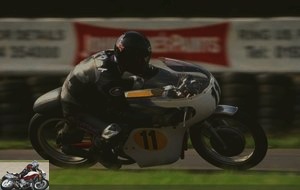 More agile than a Manx, the Monard is also less balanced
More agile than a Manx, the Monard is also less balanced
This is one reason why Monty had fitted a wider WM3 rear rim, to reduce this tendency, but without completely correcting the problem … until now! The reason is certainly the more robust construction of the modern Avon rear tire that Mike Braid rode that crashes less under acceleration while providing more grip than it did back then. The other side effect of these modern tires is the reduction in ground clearance: the Monard rubs its left footrests on Elbow and right on the Esses. Fortunately, boot sliders have since been invented as well….
Conclusion
It’s hard to stress enough how impactful Geoff Monty’s work was, first creating the GMS 250 with Roland Pike and then the Monard twins with Allen Dudley-Ward. These remain the epitome of the art of the trainer, as expressed through circuit racing and as such, they are an important part in the history of road racing..
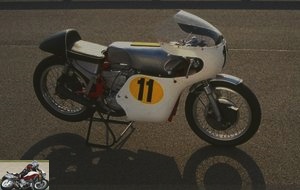 The Monard 650
The Monard 650
Strong points
- A piece of history
- Agility
- Motor
Weak points
- Stability
- Braking
The technical sheet of the Monard 650
Related articles
-
Laverda 915 SFC motorcycle test
Post-classic queen 915 cc parallel-twin, 90 hp, steel subframe, 167 kg It’s been 20 years since the last Laverda left the brand’s factories, but the…
-
Ducati 350 SCD motorcycle test
From the circuit to the road for the Italian sportswoman 4-stroke single cylinder, 340 cc, 42 hp, 210 km / h, 112 kg dry In 1954, the arrival of Fabio…
-
Aprilia Tuono 1000 Factory Pikes Peak motorcycle test
Survive and win V4 at 65 ° of 1.078 cm3, 170 hp, 170 kg, victory and record at the Pikes Peak Motorcycle racing is inherently perilous, but there aren’t…
-
Kawasaki Z1B Moriwaki motorcycle test
Wild and brilliant roadster 4 cylinders in line, 1,135 cm3, 119 hp, 160 kg It has been exactly 40 years since New Zealander Graeme Crosby entered the GP…
-
Harley-Davidson VR 1000 motorcycle test
The first American superbike 60 ° V-Twin of 996 cm3, 135 hp and 107 Nm, 177 kg, 50 units produced 1995! 25 years ago! This date is a major milestone for…
-
Triumph Daytona 955i motorcycle test
Centenial Edition – English elegance GSX-R1000, R1, CBR 900 … There are the hyper-sports which are always on the front of the stage and then there are…
-
OJ Yamaha YZR250 OWL5 motorcycle test
The 2000 GP250 World Champion 90 ° V-twin, 249 cc, 97 hp, 268 km / h, 97 kg In 2000, Olivier Jacque dazzled Grand Prix enthusiasts riding the Yamaha of…
-
Triumph Speed Triple R 1050 motorcycle test
A top-class Speed Triple From the luxury spokes from Ohlins for the suspensions, Brembo for the monobloc calipers and PVM for the forged wheels, the…
-
Honda CB1100R T-Rex motorcycle test
The best Post-Classic sports car ever built 4 cylinders in line, 1,156 cm3, 145 hp, 160 kg, Harris frame, 273 km / h A T-Rex is big, strong, powerful ……
-
Royal Enfiel RE350 Brass Rajah motorcycle test
The Indian Bobber King of Brass 346 cc single cylinder, 19.8 hp, 28 Nm, 155 kg dry The customization of motorcycles has known for a decade a continuous…
That’s what I also said to myself, 120 km at 8L is 10L so there are only 6 left, sacred reserve.
The indicator light (since there is no gauge) is very considerate …
daily use? must have the means
In fact the 120km is when the reserve light comes on, namely that there is a reserve of about 6 liters. On my ducati streetfighter v4S it’s like that,
Checking the valve clearance every 24,000km and changing the belts every 3 years, here is the new Streetfighter of the people !! Welcome to her.
—
http://www.motovirolo.com: the club of corner traders